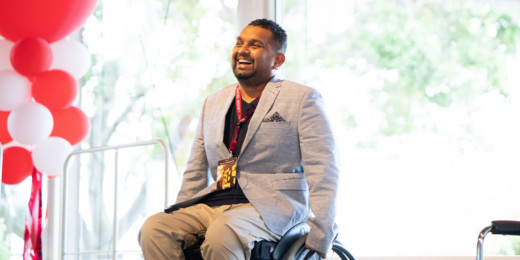On Sunday morning, speakers at Stanford Medicine X | ED offered two themes for the future of medicine: data and design thinking.
First, Dean Lloyd Minor, MD, outlined the progress and potential of the field's digital transformation.
New ways of collecting and evaluating health data -- through smartphones, other wearables and electronic medical records -- present an opportunity for health providers to improve their care and for consumers to play a larger role in managing their health, he said.
Technology and the data are also integral to efforts to improve prediction, prevention and curing of diseases through precision health, Minor said.
He cited two examples: In the Apple Heart Study, Stanford researchers are working with the tech company to learn more about atrial fibrillation, a common heart condition, using data provided by participants wearing Apple Watches. In Project Baseline, Stanford is collaborating with the biotech organization Verily and others to collect health data through customized wearables to gain a better understanding of health and illness.
"The goal here is to be able to, for each of us, develop a specific plan of prediction that then can lead to prevention of disease," Minor said.
Though venture capitalists have joked that data science will render human doctors obsolete, Minor predicted the opposite:
The digital transformation of health, health care and biomedicine offers us as educators, as physicians, as health care providers a unique opportunity to return to the high-touch aspects of medicine, because those high-touch aspects are enabled by high tech.
The morning's keynote speaker, Bon Ku, MD, concurred that medicine will continue to need the human touch -- specifically, human creativity as practiced through design thinking.
"How is our experience with health care so bad at times? I think part of it is that health care wasn't designed. It literally just happened by accident," said Ku, the assistant dean for health and design at Sidney Kimmel Medical College at Thomas Jefferson University.
He offered a list of "design fails," ranging from hospital gowns that fly open to X-ray images that can't be transferred into a patient's electronic record. He showed oral and rectal thermometers that looked exactly alike, and described how emergency departments have been known to reach the sound level of a highway or vacuum cleaner.
"It's a passion of mine to think about how to cure our terminally ill health system," Ku said.
His cure would start with encouraging more creativity in budding and practicing doctors -- an approach that, he believes, may have prevented feelings of depression and burnout that he experienced.
At Thomas Jefferson University, Ku developed a program for creative problem solving in health care for medical students, modeled on the Stanford d.school. He explained:
We try to encourage students to develop empathy for the end user before coming up with a solution, and then when they understand the problem, to rapidly prototype a solution, and then test that out right away with users and iterate on that solution, and then repeat that process over and over again.
His students have used design thinking to find ways to reduce fear and anxiety of patients undergoing radiation therapy, and to create a checklist for treating sepsis patients in emergency departments before they're transferred to an inpatient floor.
His team also has ventured into a Philadelphia community where the life expectancy is comparatively low, and met with residents and local organizations. As a result, there are now plans to convert a trailer to meet neighborhood needs, and there are other ideas for nutrition and beautification. Ku said:
I want clinicians of the future to not only think about treating the patient in front of them, within their examination rooms, but also to think about how to care for the communities where these patients are from.
Photo by Justin Lai / Stanford Medicine X | ED






